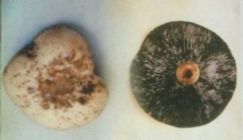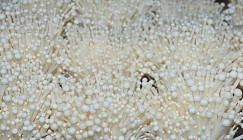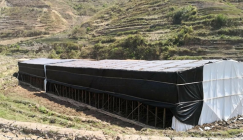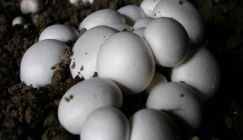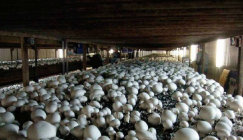1. Late inoculation: it is late to start the inoculation in April, the infection of sundry fungi is easy to happen when the weather is warming up. Therefore, it is best to inoculate between February and March. The spawns of mushroom will begin to bud and grow in above 5 degrees and mould will massively appear in above 15 degrees. So, in order to avoid infection, people could conduct early inoculation and control spawn running in low temperature.
2. People could mix the sawdust of pine tree in substrate because the sawdust of pine tree has bacteriocidal substance.
3. Aged stains: the optimal age of strain is about 40 to 50 days after inoculating. The aged strains possess matured myceliums. The growth speed of spawns is slow, in later period, it is easy to infect sundry fungi. People could store strains that were produced in early period under 4 degrees to prevent aging.
4. Undemanding indoor aseptic operation: in rural cultivation, there almost has no settled inoculation room and most of inoculations are done in private residences, in where the risks of contamination is high. So, people could strictly adhere to aseptic operation. Inoculation room and mushroom house should be disinfected thoroughly, walls and greenhouses should be painted with lime for one time. All the tools and plastic films should be soaked in 3% of lysol. During the cultivation period, operators should always wear white gown, wear hat and mask. Before cultivating, they should firstly wash hands and disinfect with 75% of alcohol wipes before operating. All the people should not be allowed to access to the inoculation room. Smoking, spitting and talking should be strictly prohibited. After putting in shelves, people could spray 3% of Bordeaux mixture at regular intervals.
5. Small amount of inoculation: in normal situations, the proportion of compost and strain is 10 to 1. If the amount of inoculation is partial small, it will cause slow growth trend on spawns and high infection rate. The infection rate is low when the proportion is controlled in 10 to 1.5 or 10 to 2.
6. Materials-steaming and inoculation are out of sync: the pollution rate is high when farmers choose to steam materials intensively and inoculate after few days. The correct approach is to conduct packaging or bagging while materials are hot, lower the temperature indoors and inoculate on the same day. It is wrong to delay till the next day.
7. Hidden peril in old mushroom house: old mushroom house possesses many spores of sundry fungi, which are easy to cause infection. Therefore, before cultivating, people could disinfect and paint the walls again and use two kinds of disinfectant drugs to conduct cross disinfection.
8. Ratio imbalance between bran and sawdust: when mixing material, the proportion of bran should be controlled under 20% or it will cause infection and rancidity that are caused by poor ventilation. What’s more, bran should be fresh. Acescent and moldy materials should not be used.
9. Environmental pollution: people could choose the cultivation sites where have fresh air and good ventilation. Dung yard, livestock house and scrap heap should be avoided in surrounding areas.
10. Too thick fungus blocks: it is best to remain the thickness in about 8cm. The infection rate is high when fungus blocks are too thick and the growth time of spawns in the substrate is long.
11. The wrong usage of old plastic films: old plastic films exist high infection rate. If you have to use old plastic films, you could firstly wash with alkaline water and soak with 3% of lysol for a day and night, then ladle out and shake off drops of water before using.
12. High humidity in mushroom house: during the growth period of spawns, the relative air humidity of mushroom house should be below 70%. But high humidity is needed during the period of fruiting. People could increase ventilation when encountering high humidity and put quick lime indoors to make moisture absorption.
13. High moisture in fungus blocks: the humidity of compost on Pholiota nameko should be below 65%, spawns will have slow growth in high moisture. If the spawns have penetrated 1cm, people could turn fungus blocks over and make spawns grow continuously.
14. Direct sunlight on fungus blocks: the cultivation od spawns should be kept out of sun and it is proper to remain certain scattered light. The growth of spawns will be inhibited if they are being exposed to direct sunlight for a long time. Therefore, people could conduct lucifuge cultivation and avoid direct sunlight on fungus blocks.
15. Dead corners on ventilation: oxygen is needed during the growth period of spawns. With good ventilation, spawns will enjoy desirable growth trend and spread all over the substrate ahead of time. So, when building mushroom house, people could make sure that north and south windows are even and big. Ground windows should be set in parallel with the ground and ventilation holes should also be set on the roof.

 LATEST NEWS
LATEST NEWS
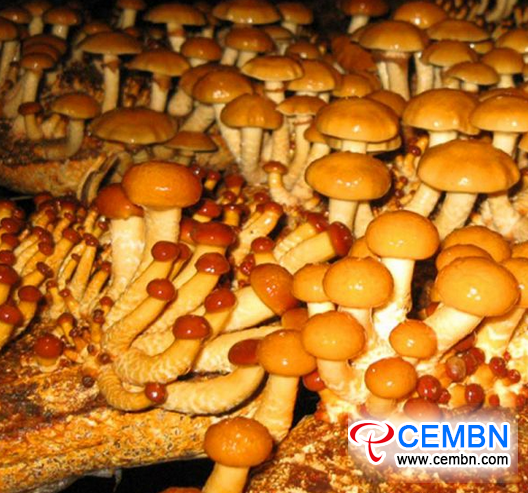
 MOST POPULAR
MOST POPULAR
